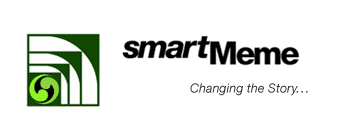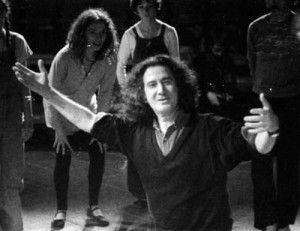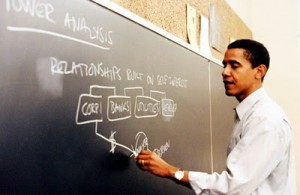This is Part 4 of a series on Art and Power
Where is the power? That’s the question at the core of a power analysis, one of the most useful tools that community and movement organizing have today. While it can look different across organizations, a power analysis basically charts out the power relationships relevant to a campaign, an issue, or a movement.
A youth organizing group taking on discipline policies in schools, for example, might gather together and map out who really holds power over discipline policies. Can the principal change them on her own? Is it mandated by the district? Is it a state government matter? What outside forces are supporting the current policies? Who funds them? These questions help the organization to choose allies and targets. On the flip side, power analysis can be done on ourselves. What kinds of power do we have? Where does our power come from? How is it best used?
Cultural organizers and arts activists may struggle to answer these kinds of concrete questions, as we work in the realm of culture and are often taking on invisible forms of power. But there are a few methods that I’ve run across that could be helpful in this regard.
 One of the most comprehensive frameworks to help groups do power
analysis is that developed by John Gaventa at the Institute of Development Studies, building
on the work of many organizers and academics. It is called the Power Cube, and it breaks
down power across three axis: levels of power (global, national, local, household), spaces
where power is exercised (closed, invited, and claimed) and forms (visible, hidden, and
invisible). The power cube helps us to look not only at formal decision making, but at the
cultural and psychological aspects of power — key to the work of cultural organizing. This
tool has been used by groups around the world, and you can find an interactive explanation
and many examples at the power cube site.
One of the most comprehensive frameworks to help groups do power
analysis is that developed by John Gaventa at the Institute of Development Studies, building
on the work of many organizers and academics. It is called the Power Cube, and it breaks
down power across three axis: levels of power (global, national, local, household), spaces
where power is exercised (closed, invited, and claimed) and forms (visible, hidden, and
invisible). The power cube helps us to look not only at formal decision making, but at the
cultural and psychological aspects of power — key to the work of cultural organizing. This
tool has been used by groups around the world, and you can find an interactive explanation
and many examples at the power cube site.
 Another fabulous process is narrative power
analysis, developed by SmartMeme and outlined in their book Re:Imagining Change. This analysis can help groups who want to shift
the cultural discourses around their issues as a key part of addressing injustice. First
groups analyze the current narratives that are helping to maintain the status quo by making
injustice seem normal, inevitable, or justified (for example, the narrative of meritocracy
and “pulling yourself up by your bootstraps” helps to justify poverty). Next, groups figure
out where these narratives are weakest — for example where they contain unstable
contradictions. Finally, groups build new, truer stories meant to challenge, subvert, or
replace these dominant stories. This is part of SmartMeme’s “story-based strategy.” While
such a strategy doesn’t need to involve art per se, it is inherently cultural in nature, and
quite in line with the goals and principles of cultural organizing.
Another fabulous process is narrative power
analysis, developed by SmartMeme and outlined in their book Re:Imagining Change. This analysis can help groups who want to shift
the cultural discourses around their issues as a key part of addressing injustice. First
groups analyze the current narratives that are helping to maintain the status quo by making
injustice seem normal, inevitable, or justified (for example, the narrative of meritocracy
and “pulling yourself up by your bootstraps” helps to justify poverty). Next, groups figure
out where these narratives are weakest — for example where they contain unstable
contradictions. Finally, groups build new, truer stories meant to challenge, subvert, or
replace these dominant stories. This is part of SmartMeme’s “story-based strategy.” While
such a strategy doesn’t need to involve art per se, it is inherently cultural in nature, and
quite in line with the goals and principles of cultural organizing.
 Finally, Augusto Boal’s Theatre of the
Oppressed (TO). I was trained in these techniques in college, and was fortunate to
attend a workshop with Boal before he passed away. Boal saw the possibility that theatre
could be, if not the revolution, then “rehearsal for the revolution.” As a method of power
analysis, TO is particularly good at addressing very personal and internal forms of power.
TO brings people together to explore how oppression functions in their lives, and how they
might confront it, by quite literally performing different possibilities. It starts not with
big ideas — racism, homophobia — but with their everyday manifestations. Through image
theatre, forum theatre, and the largely internal rainbow of
desire, we can come to better understand — cognitively, emotionally, kinetically —
what forces shape our lives, and what power we have to create real change.
Finally, Augusto Boal’s Theatre of the
Oppressed (TO). I was trained in these techniques in college, and was fortunate to
attend a workshop with Boal before he passed away. Boal saw the possibility that theatre
could be, if not the revolution, then “rehearsal for the revolution.” As a method of power
analysis, TO is particularly good at addressing very personal and internal forms of power.
TO brings people together to explore how oppression functions in their lives, and how they
might confront it, by quite literally performing different possibilities. It starts not with
big ideas — racism, homophobia — but with their everyday manifestations. Through image
theatre, forum theatre, and the largely internal rainbow of
desire, we can come to better understand — cognitively, emotionally, kinetically —
what forces shape our lives, and what power we have to create real change.





One thought on “Where is the Power? Creative Power Analysis and the Arts”
Comments are closed.